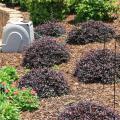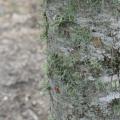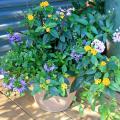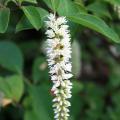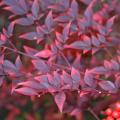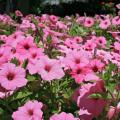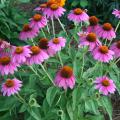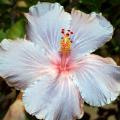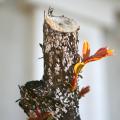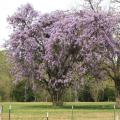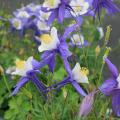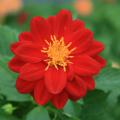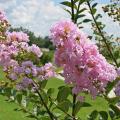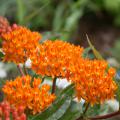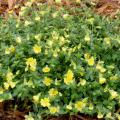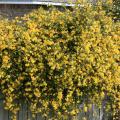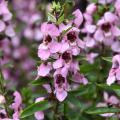Southern Gardening from 2015
Because we haven’t yet had much of what you would call winter weather in Mississippi, we’re seeing some earlier-than-normal garden activity.
I thought the one cold snap we had in December put the landscape to bed for the season, but since then, the bananas, elephant ears and canna have started pushing new growth in my coastal landscape. I know this is probably short lived, but I’m enjoying it nonetheless.
Winter is a good time to examine landscape plants. With many of the deciduous plants dropping their leaves, it is easy to see defects and other problems, especially strange things growing on the landscape plants.
Extension offices all across Mississippi are going to be receiving calls from concerned homeowners about a moldy-looking, gray-green stuff on their plants. The cause for the concern 99 percent of the time is an organism called lichen.
Many gardeners have their sights on the garden and landscape at the beginning of this new year. The mailman is fueling this garden interest with all the seed and plant catalogs being delivered. I spent a recent weekend looking through the 18 catalogs I already had and have ordered all of the seeds for this year’s vegetable garden.
If you’re like me and most other home gardeners, you want shrubs to have multiseason interest and be versatile, beautiful AND low maintenance. This is no small list to consider when looking for shrubs at the garden center or nursery.
I may know the ideal shrub that has all these traits and is also a Mississippi native. Virginia sweetspire is perfect for the shrub border or woodland setting. In fact, Virginia sweetspire was selected as a Mississippi Medallion winner for 2011.
Cold winter weather causes changes in the foliage of many evergreen plants, including making them express new colors.
For instance, Japanese cleyera produces rich, velvety burgundy foliage along with bright red petioles. I really like the way the boxwoods in my landscape develop a warm, orangey-bronze, but if I had to pick my favorite evergreen for cold weather color, it would have to be nandina.
There are a lot of different traditions and customs when it comes to predicting the weather. Just last week, we looked to that venerable weather creature, the ground hog Punxsutawney Phil, to tell us how many more weeks of winter before we can expect spring to arrive.
With the cold winter weather upon us, are you thinking about planting annual color for the summer? It’s never too early to plan ahead, and thinking about the beautiful landscape you’ll have in the summer is one way to enjoy the dreary winter months.
One of the reliable summer-color plants I like the most is the petunia, and in my opinion, you can’t go wrong with Supertunias. Their selection of colors allows you to work with any color scheme.
This past weekend really had me thinking about gardening and landscaping. It was an unseasonal 79 according the thermometer at my house, and I started to putter around the yard, trying to decide what needed to be done to get ready for spring.
Of course, I made a trip to see what plants were on the benches at the local garden center. But by afternoon, I had come to my senses. According to the weather forecasted for this week in much of Mississippi, we haven’t seen the last of winter.
Through the column and television show “Southern Gardening,” I have the chance to share some of my favorite landscape plants with home gardeners all across Mississippi. And believe me, I have a lot of favorite plants depending on the season, flower color and more.
This week as I’m getting ready for summer, I’m thinking hard about purple coneflower, known botanically as Echinacea.
Mother Nature has been teasing gardeners lately as the weather flips back and forth from warm, early-spring days to freezing temperatures and winter precipitation. I want summer to arrive!
This weekend kicked off the spring gardening season with the Garden Extravaganza in Biloxi. What a relief it was to browse the booths, checking out the latest in spring garden and landscape offerings and speaking with growers. I enjoyed the change from flipping through the big stack of garden catalogs and binge watching home and garden TV shows.
It seems that crape myrtles face a lot of dangers this time of year.
Many still face “crape murder,” or being butchered by having their branches improperly cut off at the same place every year. A novice gardener sees a so-called “professional” landscape company do it, so they think they need to cut their own crape myrtles in the same way. In horticulture CSI terms, this is a classic copycat crime.
But this column is about another threat to our beautiful crape myrtles.
I enjoyed the warm spring weather while driving around south Mississippi this past weekend. One of the sights I noticed for the first time this year was the wisteria starting to bloom.
Wisteria doesn’t bloom at the first sign of warm weather. It’s one of those plants that waits patiently and is a good indicator that spring has officially sprung.
I’m always amazed at how high wisteria can climb into the tops of the trees, showing off how vigorous and aggressive these plants can be. As such, they can seem to be a little too much for the typical home landscape.
After living in the North, I miss some of my favorite spring and summer plants as I now live in coastal Mississippi. Columbine is one I miss, as I love the way the flowers seem to be suspended in midair by the slender stems as if floating on a gentle breeze.
In my opinion, you need a columbine regardless of where you garden. Columbine can grow in Mississippi if you treat it as an annual because of our shortish springs and long, hot summers.
In my travels visiting garden centers and greenhouses, I’ve been reminded of plants that we don’t grow enough in Mississippi. Dahlias are on that list.
I can’t decide if it’s because gardeners think these beautiful plants need an extraordinary amount of care or they’re just not aware of them, but we need to grow more dahlias.
Dahlias grow from bulb-like structures that resemble sweet potato tubers. They are easy to grow, and if you can grow tomatoes, you can grow dahlias.
There’s been a lot of attention paid to the matter of pruning, especially with the crime against horticulture known as “crape murder.” But we’re also in early spring, when many gardeners want to tidy up their landscape plants, and I’m no different.
This weekend, I removed a couple of large, overgrown junipers that the previous homeowner had planted. Feeling invigorated and empowered, I proceeded to prune back the small Indian hawthorn hedge along my front walk. And this is a warning to my foundation planting of boxwoods: You’re next.
Even though we’re still early in spring, we need to get ready for the sweltering temperatures we know are on the way. This means we have to start planting two of my favorite summer plants that pack a powerful punch of summer color: SunPatiens and sun coleus.
SunPatiens love growing in full sun during the hottest parts of summer. SunPatiens are an improvement of New Guinea-type impatiens that can be grown in full sun. They have beautiful variegations and bloom from the time they are planted in late April or May through the fall.
Home gardeners are showing more interest in planting native plants in the landscape. This makes a lot of sense because native plants have a greater tolerance to local environmental conditions. What holds them back is the fact that many have a limited ability to create excitement in the landscape.
One that defies that stereotype is the butterfly weed. This native plant was chosen as a Mississippi Medallion winner in 2012, an award given to plants selected for their superior and outstanding garden and landscape performance.
If there's one area in almost everyone's landscape that causes a lot of problems, it's that area between the sidewalk and the street.
I surrounded my mailbox with a small planting bed to help me try to garden in this area. I have had some success trying many different planting combinations that change with the seasons. But it is the summer that causes me the most trouble.
If you’re looking for something for your landscape that you’ve never tried, may I suggest flowering vines. Many gardeners enjoy these plants but don’t really give them enough attention except when they’re blooming in the spring.
Two of my favorite flowering vines are yellow jasmine and Confederate jasmine.
Many seasoned gardeners, myself included, consider Angelonia one of the best plants for the hot summer garden.
Angelonia, a member of the snapdragon family, is actually called summer snapdragon. It thrives in the full sun during the heat and humidity of summer. Since this describes our usual summer weather, tolerance to these conditions is a requirement for our Mississippi gardens and landscapes.
The garden world is dominated by plants with round flowers, so the spiky texture of the Angelonia flower stalks is a welcome addition to any summer garden.

